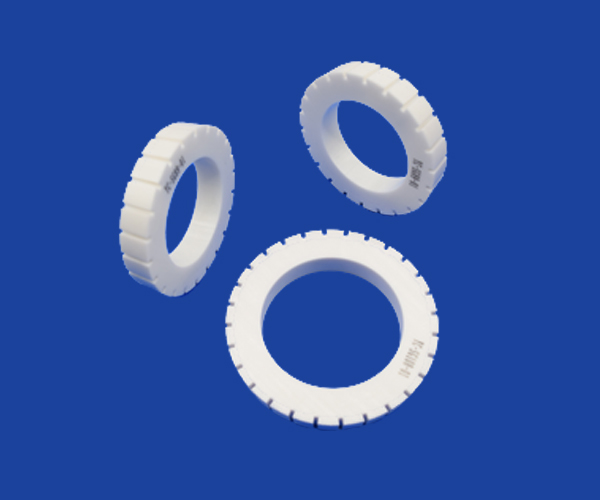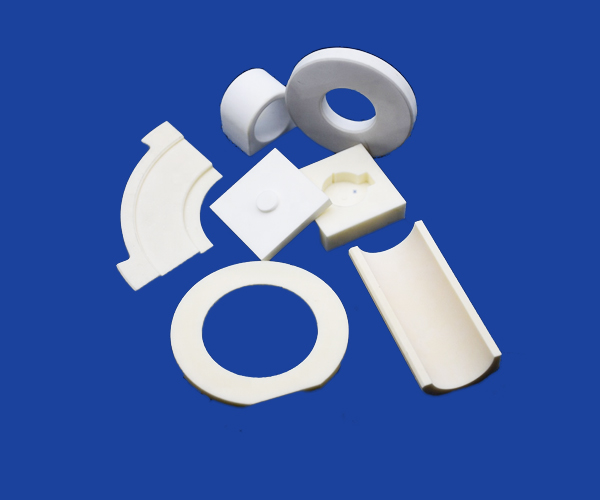Application of alumina ceramics in all-ceramic bonding Bridges
Time: 2020-03-06 Writer: mingrui
Abstract: dentition defect is a common and frequently occurring disease in oral prosthodontics. Traditional prosthodontic methods have their advantages and disadvantages, but they are not suitable for all cases of clinical dentition defect.As a kind of "minimally invasive, beautiful, fixed and comfortable" repair method, all-ceramic bonding bridge plays a role in the repair of dentition defect, and its application is more and more extensive.At present, there are different opinions about the repair effect of all-ceramic bonding bridge, and its clinical application is still controversial.This paper reviews the research progress and clinical application of all-ceramic bonding Bridges in order to provide guidance for related research and application.

Adhesive bridge is a kind of fixed bridge prosthesis which does not require the removal of a large number of abutment tooth tissues and USES adhesive technology to repair the loss of individual teeth.Compared with the traditional fixed bridge, the adhesive bridge repair has the advantages of minimally invasive, less stimulation of periodontal tissue, and more room to choose other repair methods after the repair body falls off.Although the traditional metal wing plate bonding bridge has good mechanical properties, its metal underframe has a bad effect on the color of abutment and bridge body, which is not enough in aesthetics, and its clinical application is greatly limited.With the continuous progress of dental ceramic materials and bonding technology, the appearance of all-ceramic bonding bridge has greatly improved the beauty and biocompatibility of this kind of restoration technology, which is more and more favored by dentists and patients.
An all-ceramic restoration system commonly used in all-ceramic bonding Bridges
According to the different processing technology and materials, the ceramics commonly used in bonding bridge manufacturing can be divided into: plastic-coated glass permeable alumina ceramics, hot-pressed casting lithium silicate glass ceramics, and CAD/CAM zirconia ceramics.
1.1 slurry coated glass penetrates alumina ceramics
Alumina plastic-coated all-ceramic restoration consists of aluminum oxide slurry coated on a type of refractory material and sintered for 10 hours at 1120℃ to form a porous alumina scaffold, and then sintered for 4 hours at 1100℃ to allow the molten glass matrix to penetrate into the scaffold to eliminate pores, increase strength and limit crack diffusion.Finally, the ceramic core was coated with plastic veneer porcelain to complete the production of the restoration.Vitreous osmotic zirconia porcelain is a modified material based on traditional vitreous osmotic alumina ceramics, adding 35% zirconia to enhance its mechanical strength. Due to the lack of semi-transparency of the material, it is mainly used in the manufacture of single crown and fixed bridge in posterior tooth area.Scholars have also obtained satisfactory results in the clinical research of glass permeable alumina bridge repair.
1.2 hot press casting of lithium silicate glass ceramics
The transparency and refractive index of hot-pressed lithium silicate glass ceramics (hereinafter referred to as porcelain casting) are close to the natural tooth enamel, the color of porcelain casting restoration body is realistic, the edge is close, it is recognized as the best all-ceramic restoration material with aesthetic effect.At the same time, with the continuous development of porcelain casting materials, the new generation of porcelain casting restoration materials represented by IPS e.ax press have excellent aesthetic effect and mechanical strength.At the same time, casting glass ceramics is a kind of acid-etched ceramic material, chemical acid etters can selectively dissolve the glass matrix in the material, forming an irregular surface, increase the bonding area, bonding resin can infiltrate into the formation of mechanical locking, in order to get a good bonding effect.A clinical retrospective study by Irena Sailer et al. showed that the restoration success rate of porcelain cast bonded Bridges was 100% during the average 6 years of observation [2].The study of s. halder et al. showed that the success rate of 5 years and 8 years of the cast-porcelain bonding bridge for the retention of the posterior embedded teeth was 57% and 38% respectively. Therefore, it is not recommended to use the cast-porcelain bonding bridge to repair the missing posterior teeth.
1.3 CAD/CAM zirconia ceramics
Zirconia ceramics is one of the clinical use of ceramic repair materials in the mechanical strength of the highest, yttrium oxide stable zirconia ceramic flexural strength of more than 900 mpa, Sasse, etc of a front teeth all single-ended retainer zirconia ceramic adhesive to repair the bridge clinical study showed that the restoration approach of 6 years and the success rate was 91.1%, suggest it can be used as an alternative way of clinical used to repair a single front tooth loss.Although laboratory studies have shown that it can bear a large loading force, clinical studies have shown that its long-term success rate is not ideal. The main reasons for the failure of the restoration are the disbonding of the restoration body, the fracture of the connection body and the collapse of the bridge veneer porcelain.
Design of retainer of all-ceramic bonded bridge

2.1 retainer design of all-ceramic bonding bridge for front teeth
The retainers of the front teeth all-ceramic bonding Bridges are mostly designed in the style of tongue flanking plate. At the same time, two auxiliary retainers, a small box-shaped hole and a shallow nail hole on the tongue protuberance, are set on the adjacent surface near the gap to obtain sufficient bonding area and a certain mechanical retainer.According to the number of abutments involved, it can be divided into biplane and mono-plane bonding Bridges.
The double-wing bonding bridge has a larger bonding area, which can better disperse the bite force of the prosthesis, and can also act as a periodontal splint for the loose abutment teeth.However, when the motion of abutment on both sides is inconsistent, shear force is prone to appear between the wing plate and abutment in the functional state, which leads to the disbonding of the repair body or the fracture of the connector.As the bridge body is connected with the abutment tooth, it has the same degree of motion, which weakens the shear force and torsion force of the bridge body.A large number of comparisons have been made between the two retention methods, and it is shown that the repair effect of all-ceramic or PFM bonded Bridges with single fin design is better than that of bifoil design.
2.2 retainer design of the posterior all-ceramic bonding bridge
The masticatory force in the posterior tooth region is large and the acting direction of the force is complex. The simple wing plate design cannot meet the requirements of retention, resistance and support. The design of the posterior tooth retainer is mainly inlay.Compared with the traditional fixed bridge, the abutment tooth preparation is greatly reduced and the healthy tooth tissue is preserved.In the early stage, due to the brittleness of all-ceramic materials, the rear-tooth embedded all-ceramic bonding Bridges often failed due to the lack of mechanical strength.At present, with the continuous improvement of the properties of ceramic materials, the success rate of its repair has been significantly improved.
Bonding and retention of all-ceramic bonding Bridges
3.1 abutment bonding surface
The adhesive surface of abutment can be divided into enamel adhesive surface, dentine adhesive surface and enamel dentine mixed adhesive surface.Tooth enamel can be acid etched and demineralized by acid etch agent to form porous mesh surface.The dentin is rich in water and protein, and the dentin tubules and other special structures significantly affect its adhesiveness.The adhesive effects of the three adhesive surfaces were successively > mixed adhesive surfaces > dentin adhesive surfaces of enamel adhesive surfaces.In terms of adhesive surface treatment, abutment adhesive surface cleaning is beneficial to remove the interference of organic and inorganic pollutants or water, reduce the surface tension, and improve the surface activity.
3.2 adhesive surface of retainer
The bonding surface properties of retainers of all-ceramic bonding Bridges depend on the types of materials used.Hydrofluoric acid etching is the best surface treatment for casting ceramics.In addition, the application of silane coupling agent can on the one hand improve the wettability of the adhesive on the ceramic surface, on the other hand, it can form a chemical bond with the ceramic bonding surface and the resin bonding agent respectively, so as to enhance the bonding retention between the ceramic and the resin.Alumina and zirconia ceramics are not easily corroded by hydrofluoric acid, and their bonding surface is not easy to form a chemical bond with simply coated silane coupling agent.Sand blasting treatment can increase the roughness of zirconia ceramic bonding surface, and form an effective micro-mechanical retention structure, so as to enhance its mechanical bonding force with resin adhesive.
4. conclusion
At present, there is still some controversy about the clinical repair effect of all-ceramic bonding Bridges, especially the posterior all-ceramic bonding Bridges.We have reasons to believe that with the continuous exploration and practice of doctors and scholars and the continuous progress of materials science, the shortcomings of all-ceramic bonding bridge repair technology will be made up gradually, its advantages will begin to show, and its clinical application will be more widely promoted

 Moble: +86 18122974730
Moble: +86 18122974730 Phone: +86 0769-85090316-8038
Phone: +86 0769-85090316-8038 Email: admin@cerampart.com
Email: admin@cerampart.com Skype: admin@cerampart.com
Skype: admin@cerampart.com Wechat: +86 18122974730
Wechat: +86 18122974730
